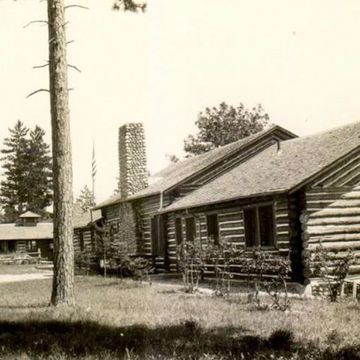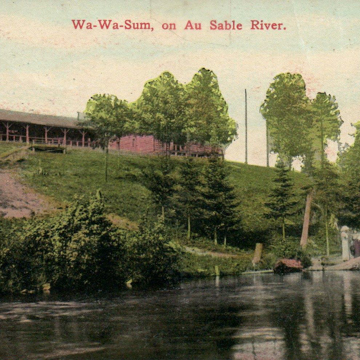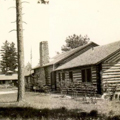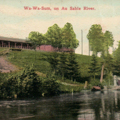You are here
Wa Wa Sum
Wa Wa Sum is one of the best examples of a summer fishing camp on the “Holy Water” stretch of the Au Sable River, once the best fishing section of the state's outstanding trout stream. It was built and added to between 1898 and 1933 for J. Secor and James Brown Bell, of the Secor & Bell brokerage firm, and other Toledo industrialists and businessmen, who in 1898 acquired 250 logged-over acres high on the north bank of the river. The river was the habitat of brook, brown, and rainbow trout as well as grayling. For the fishermen and their families the camp served as a base of their vacation operations. The camp was named Wa Wa Sum, which means “Plain View” in Chippewa and refers to the unobstructed view to the south that existed before reforestation.
The camp consists of six one-story log buildings: a main lodge (1921–1922); a dining room, kitchen, and a caretaker's building (1897–1898); a recreation building known as the bullpen, where the men played poker (1907); the river guide's cabin (1933); and a boathouse and barn (1933). All are built of red pine logs on a base of tamarack logs. Some have fieldstone foundations and chimneys. From each end of the large main room, which is arranged around a huge stone fireplace, extend sleeping areas that were for the Secor-Stranahan families and the Bell family. Each wing has three bedrooms, a kitchen, and bath. A porch runs along the south side of the building, overlooking the river and boat landing below. Riverboats, unique craft indigenous to the Au Sable River, are housed in the open-sided pole-frame boat shed. The long, narrow, flat-bottom boats are suited for the fast-moving shallow waters of the river. The guide takes the stern, the fisherman the bow. Live fish wells located in front of the guide's seat held water in which the catch was stowed. Rubin Babbitt, an Au Sable River guide in the Grayling area, built the earliest structures; Ed Kellogg of nearby Lovells built the later buildings.
The women and children of the Secor-Stranahan and Bell families typically spent the summer at Wa Wa Sum; the men came on the weekends. Leaving Toledo after work on Thursdays, they were greeted at the Grayling railroad depot at 4:30 a.m. by the camp's river guides, who had paddled the riverboats through the night seventeen miles upstream from the camp. Then they fished their way downstream to the camp.
Wa Wa Sum is similar to other camps, such as Camps Gingerquill, Pahwanee, Shoppenagon, and Club Thunderbird on the main stream and the North Branch of the Au Sable River. Today Michigan State University uses the camp for a research facility in fisheries, wildlife, and forestry studies, and as a meeting and retreat center for environmental and fishing groups.
Writing Credits
If SAH Archipedia has been useful to you, please consider supporting it.
SAH Archipedia tells the story of the United States through its buildings, landscapes, and cities. This freely available resource empowers the public with authoritative knowledge that deepens their understanding and appreciation of the built environment. But the Society of Architectural Historians, which created SAH Archipedia with University of Virginia Press, needs your support to maintain the high-caliber research, writing, photography, cartography, editing, design, and programming that make SAH Archipedia a trusted online resource available to all who value the history of place, heritage tourism, and learning.


















